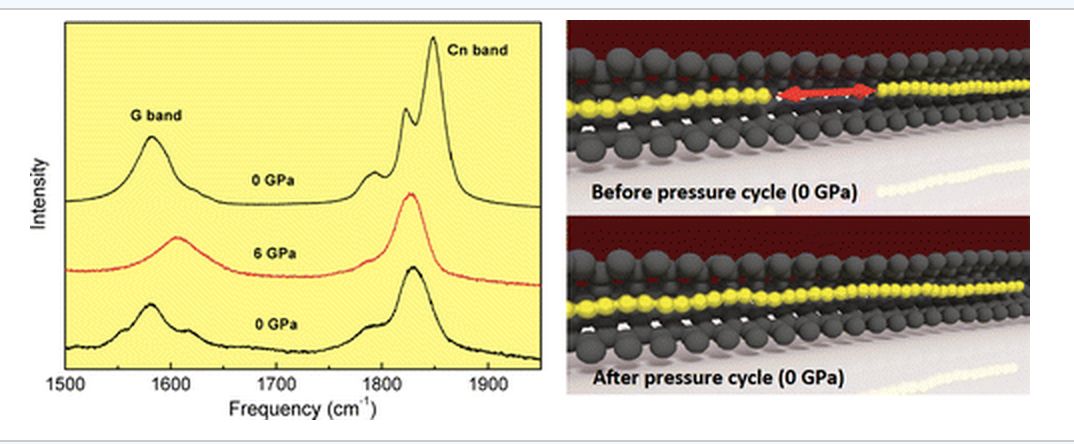Nakar, Dekel; Gordeev, Georgy; Machado, Leonardo D.; Popovitz-Biro, Ronit; Rechav, Katya; Oliveira, Eliezer F.; Kusch, Patryk; Jorio, Ado; Galvao, Douglas S.; Reich, Stephanie; Joselevich, Ernesto
Few-Wall Carbon Nanotube Coils (under review) Journal Article
In: 2019.
@article{Nakar2019,
title = {Few-Wall Carbon Nanotube Coils (under review)},
author = {Dekel Nakar and Georgy Gordeev and Leonardo D. Machado and Ronit Popovitz-Biro and Katya Rechav and Eliezer F. Oliveira and Patryk Kusch and Ado Jorio and Douglas S. Galvao and Stephanie Reich and Ernesto Joselevich},
year = {2019},
date = {2019-01-01},
keywords = {},
pubstate = {published},
tppubtype = {article}
}
Acrísio L Aguiar Nadia Ferreira Andrade, Yoong Ahm Kim
Linear Carbon Chains Under High Pressure Conditions Journal Article
In: The Journal of Physical Chemistry C, vol. 119, no. 19, pp. 10669–10676, 2015.
@article{Andrade2015,
title = {Linear Carbon Chains Under High Pressure Conditions},
author = {Nadia Ferreira Andrade, Acrísio L Aguiar, Yoong Ahm Kim, Morinobu Endo, Paulo TC Freire, Gustavo Bruneto, Douglas Soares Galvao, Mildred S Dresselhaus, Antonio Gomes Souza Filho},
url = {http://pubs.acs.org/doi/abs/10.1021/acs.jpcc.5b00902},
doi = {10.1021/acs.jpcc.5b00902},
year = {2015},
date = {2015-04-23},
journal = {The Journal of Physical Chemistry C},
volume = {119},
number = {19},
pages = {10669–10676},
abstract = {A high-pressure resonance Raman spectroscopy study of linear carbon chains encapsulated inside multiwalled carbon nanotubes (MWCNTs) is reported. While the frequencies of the tangential modes of carbon nanotubes (G band) harden as the pressure increases, the vibrational frequencies of the chain modes (around 1850 cm–1) decrease, thus indicating a softening of the carbon–carbon bonds in this 1D solid. Pressure-induced irreversible structural changes in the linear carbon chains are unveiled by the red shift in the vibrational modes when pressure is released. These results have been interpreted as being due to a coalescence of carbon chains, and this hypothesis is supported by state-of-the-art atomistic reactive molecular dynamics simulations.},
keywords = {},
pubstate = {published},
tppubtype = {article}
}
2019
Nakar, Dekel; Gordeev, Georgy; Machado, Leonardo D.; Popovitz-Biro, Ronit; Rechav, Katya; Oliveira, Eliezer F.; Kusch, Patryk; Jorio, Ado; Galvao, Douglas S.; Reich, Stephanie; Joselevich, Ernesto
Few-Wall Carbon Nanotube Coils (under review) Journal Article
In: 2019.
BibTeX | Tags: Carbon Nanotubes, Molecular Dynamics, Nanocoils, Raman
@article{Nakar2019,
title = {Few-Wall Carbon Nanotube Coils (under review)},
author = {Dekel Nakar and Georgy Gordeev and Leonardo D. Machado and Ronit Popovitz-Biro and Katya Rechav and Eliezer F. Oliveira and Patryk Kusch and Ado Jorio and Douglas S. Galvao and Stephanie Reich and Ernesto Joselevich},
year = {2019},
date = {2019-01-01},
keywords = {Carbon Nanotubes, Molecular Dynamics, Nanocoils, Raman},
pubstate = {published},
tppubtype = {article}
}
2015

Acrísio L Aguiar Nadia Ferreira Andrade, Yoong Ahm Kim
Linear Carbon Chains Under High Pressure Conditions Journal Article
In: The Journal of Physical Chemistry C, vol. 119, no. 19, pp. 10669–10676, 2015.
Abstract | Links | BibTeX | Tags: Atomic Chains, Carbon Nanotubes, Electronic Structure, Molecular Dynamics, Raman
@article{Andrade2015,
title = {Linear Carbon Chains Under High Pressure Conditions},
author = {Nadia Ferreira Andrade, Acrísio L Aguiar, Yoong Ahm Kim, Morinobu Endo, Paulo TC Freire, Gustavo Bruneto, Douglas Soares Galvao, Mildred S Dresselhaus, Antonio Gomes Souza Filho},
url = {http://pubs.acs.org/doi/abs/10.1021/acs.jpcc.5b00902},
doi = {10.1021/acs.jpcc.5b00902},
year = {2015},
date = {2015-04-23},
journal = {The Journal of Physical Chemistry C},
volume = {119},
number = {19},
pages = {10669–10676},
abstract = {A high-pressure resonance Raman spectroscopy study of linear carbon chains encapsulated inside multiwalled carbon nanotubes (MWCNTs) is reported. While the frequencies of the tangential modes of carbon nanotubes (G band) harden as the pressure increases, the vibrational frequencies of the chain modes (around 1850 cm–1) decrease, thus indicating a softening of the carbon–carbon bonds in this 1D solid. Pressure-induced irreversible structural changes in the linear carbon chains are unveiled by the red shift in the vibrational modes when pressure is released. These results have been interpreted as being due to a coalescence of carbon chains, and this hypothesis is supported by state-of-the-art atomistic reactive molecular dynamics simulations.},
keywords = {Atomic Chains, Carbon Nanotubes, Electronic Structure, Molecular Dynamics, Raman},
pubstate = {published},
tppubtype = {article}
}
http://scholar.google.com/citations?hl=en&user=95SvbM8AAAAJ


